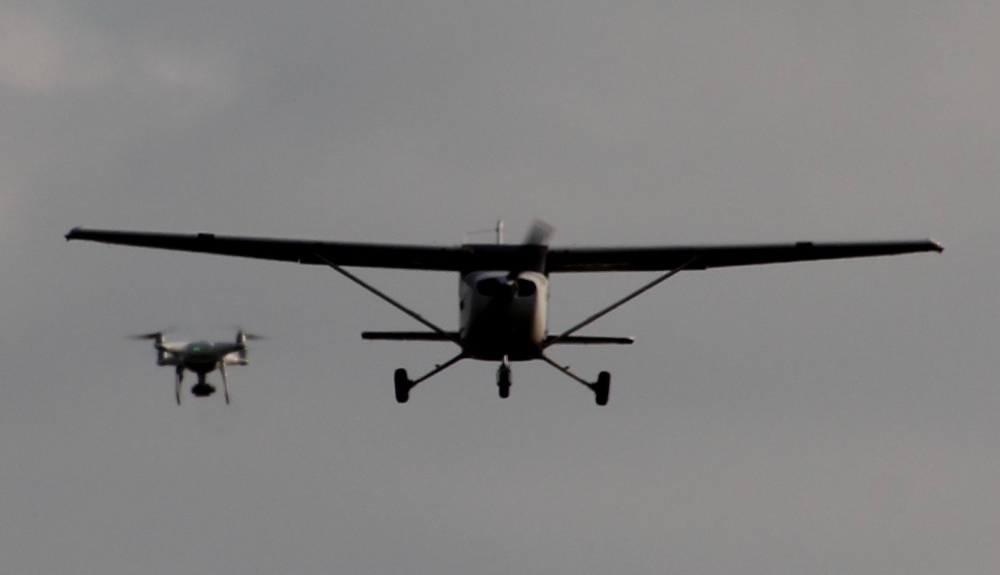Encroaching Drones Usually Go Unseen by Pilots
Can you spot the drone in this video? The pilot of the aircraft could not see it.
Skilled pilots approaching a runway usually can’t see small unmanned aircraft systems (sUAS) encroaching on their airspace, and they virtually never detect motionless drones, a newly published study shows.
During an airborne human factors experiment, certificated pilots failed to see a common type of quadcopter during 28 of 40 close encounters, researchers with Oklahoma State University and Embry-Riddle Aeronautical University reported.
In other words, the pilots got a bead on the invading drone in 12 out of 40 cases, or only about 30 percent of the time. When the drone was not moving, the task became even more difficult. A mere three out of 22 motionless drones were spotted by the pilots. Drones were detected at distances of between 213 and 2,324 feet.
These findings, published in the International Journal of Aviation, Aeronautics, and Aerospace (IJAAA), illustrate a real and growing threat to aviation safety, said Dr. Ryan J. Wallace, assistant professor of Aeronautical Science at Embry-Riddle.
“Dangerous close encounters between aircraft and drones are becoming an increasingly common problem,” Wallace said. “Statistics on pilot sightings of drones continue to increase year over year, and what is being reported by pilots is probably just the tip of the iceberg. The vast majority of the time, unmanned aircraft are not being seen by pilots.”
Even in a best case scenario, if a drone was spotted at the study’s maximum detection range of 2,324 feet, the pilot would have only about 21 seconds to avoid a collision.
“That might be enough time if the drone was hovering in one spot, but not nearly enough if it’s in flight, headed for the aircraft,” said Dr. Matt Vance, assistant professor of aviation and space at Oklahoma State. “The situation is far more dangerous when both aircraft are moving,” he said. “Our eyes are attuned to movement. When a drone is not moving, it becomes part of the background.”
An aircraft’s final approach for landing is an especially risky time for a drone encounter because “it can catch you unaware and you have little time to react,” explained Dr. Jon M. Loffi, associate professor of aviation and space at Oklahoma State. “
You don’t have the altitude to manoeuvre safely, and if an engine ingests a drone, that could bring the aircraft down.”
The research examined what happens as a pilot prepares to land and switches from instrument-guided flight to visual flight. Pilot participants were selected from a collegiate flight-training program. During the experiment, pilots conducted an approach to landing in a Cessna 172S while a DJI Phantom IV quadcopter-type drone flew a scripted series of manoeuvres along the approach path. Pilots were told that they might or might not encounter a drone.
A Growing Problem
Currently in the United States, there are more than 1.4 million registered, and likely many more unregistered drones, and they continue to proliferate, Wallace said. Close calls between drones and commercial aircraft are on the rise. On Oct. 21, 2019, for example, a commercial crew on approach to Boston’s Logan International Airport reported a drone at about 3,500 feet above ground level – higher than U.S. Federal Aviation Administration (FAA) regulations allow. The event took place a week after another crew spotted a drone after takeoff from the same airport.
While the FAA “has made strides to secure control airspace from UAS incursions,” the study authors wrote, “their efforts have been met with mixed results.” There is currently no reliable method for tracking UAS flights within the United States.
The research team’s next project will involve rigging a drone with an electronic pinging device (UAvionics Ping), which uses ADS-B (automatic dependent surveillance-broadcast) technology to track aircraft. The study will assess whether the technology helps pilots pinpoint and avoid a collision with the drone.
Leveraging UAS remote identification data has been proposed as a way to reduce the risk of aircraft-drone accidents. As of January 2020, Vance noted, no aircraft will be allowed to fly in controlled airspace near airports without ADS-B tracking technology, but the law does not extend to small unmanned aircraft. If all drones had such technology, pilots would have a more complete picture of the skies around them, thereby improving safety, Vance said.
The study, “Cleared to Land: Pilot Visual Detection of Small Unmanned Aircraft During Final Approach” was co-authored by Wallace, Vance and Loffi, along with Jamey Jacob, Jared C. Dunlap, Tyler A. Mitchell, and Seabrook R. Whyte of Oklahoma State, as well as Robert Thomas of Embry-Riddle. The research can be found on the IJAAA website.
About Embry-Riddle Aeronautical University
Reporters worldwide contact Embry-Riddle Aeronautical University for content experts in all aspects of aviation, aerospace, engineering and STEM-related fields. Our faculty experts specialize in unmanned and autonomous systems, security and intelligence, air traffic and airport management, astronomy, human factors psychology, meteorology, spaceflight operations, urban air mobility and much more.
Embry-Riddle educates 34,000+ students at its residential campuses in Daytona Beach, Florida and Prescott, Arizona, at more than 135 Worldwide Campus locations and through the nation’s No.1 ranked online undergraduate degree programs
Photo : Oklahoma State University




Ingen kommentarer:
Legg inn en kommentar
Merk: Bare medlemmer av denne bloggen kan legge inn en kommentar.